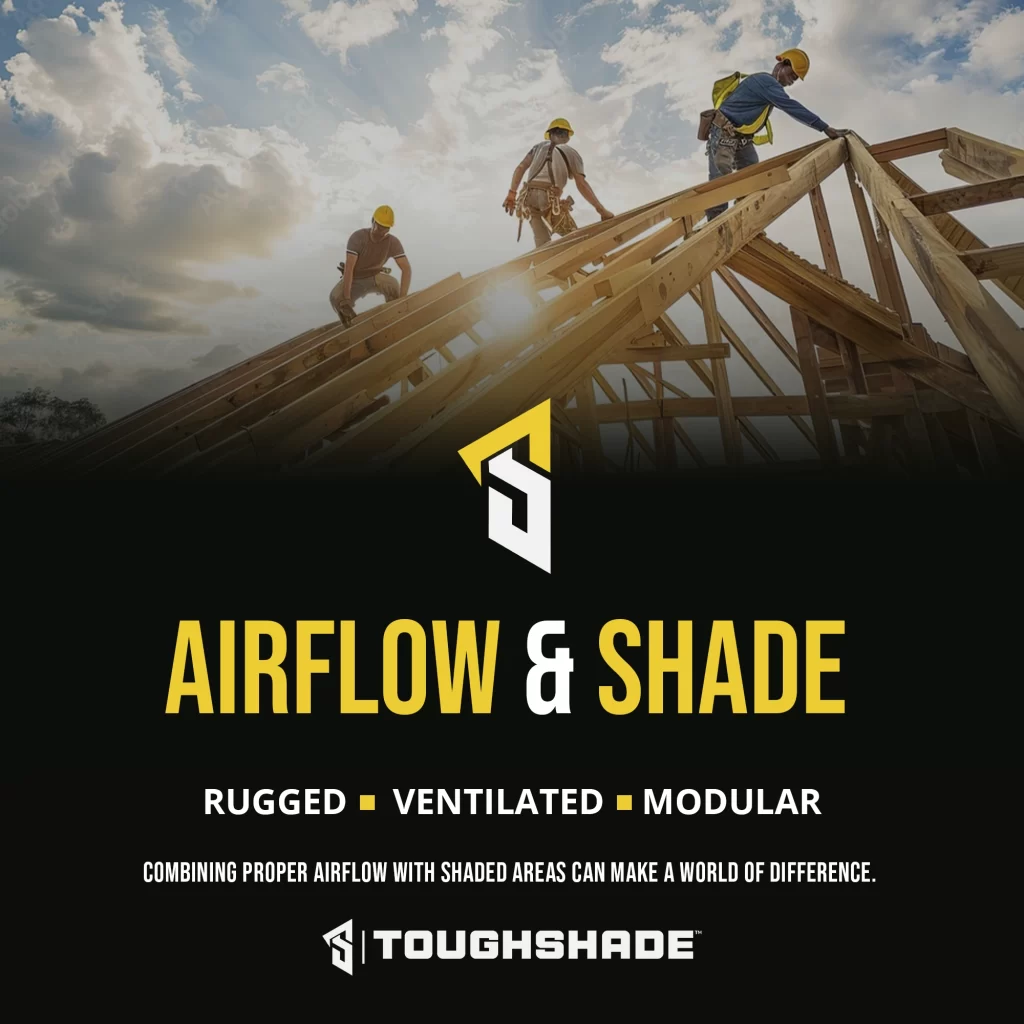How Proper Airflow and Shade Reduce Heat Load on Jobsite Workers
ToughShade™ Co. builds the most rugged, truly jobsite ready canopies – designed to protect, perform, and endure.

If there’s one thing every construction manager knows, it’s that heat can be brutal on a jobsite. Whether you’re in the middle of summer or working in a hot climate year-round, keeping your crew safe from overheating is critical.
Heat load—how much heat the body absorbs from the environment—can seriously impact workers’ health, focus, and productivity.
But there’s good news: combining proper airflow with shaded areas can make a world of difference.
Let’s dive into how this simple but effective strategy can help reduce heat load and keep your team at their best.

Understanding Heat Load
Heat load is essentially the amount of heat a worker’s body has to manage from various sources—like the sun, the temperature, and even the equipment on-site.
When the body gets too hot, it struggles to regulate itself, which can lead to heat exhaustion, heat stroke, and dehydration.
These aren’t just minor inconveniences; they’re serious health risks that can lead to medical emergencies and lost work hours. Factors like high humidity and stagnant air make it even harder for the body to cool down, which is why addressing heat load is a priority for any well-run site.
The Role of Shade in Reducing Heat Load
Shade is the first line of defense against the sun’s intensity.
By blocking direct sunlight, shaded areas can significantly reduce temperatures in specific parts of the jobsite, giving workers a place to recover during breaks.
Even a short rest in the shade can lower the body’s core temperature, helping your crew bounce back and stay productive.
But not all shade is created equal—structures like canopies with UV-resistant materials are more effective than temporary tarps or makeshift setups. Investing in high-quality shading systems can provide reliable relief for your team.
Why Airflow is Essential
While shade is a great start, it’s only half the equation.
Airflow is just as important because it allows sweat to evaporate, which is the body’s natural cooling process.
Without proper airflow, even a shaded area can feel stagnant and stifling. By creating ventilation, you’re helping your crew stay cool and reducing the overall heat load.
On sites where natural wind isn’t enough, tools like industrial fans or canopy designs that encourage cross-ventilation can make a big difference.
The Combined Impact of Shade and Airflow
Here’s where things really come together. Shade keeps the sun off your crew, while airflow helps regulate their body temperature.
Together, they create a more comfortable and safer environment for everyone on the jobsite.
Picture a canopy with open sides that lets the breeze flow through—this setup doesn’t just lower the temperature; it actively works to reduce heat stress.
The result? A healthier, more focused team that can handle the job with fewer interruptions. Some sites have reported significant reductions in heat-related incidents after implementing these simple solutions.
The Benefits Beyond Safety
The benefits of reducing heat load go beyond just keeping people safe.
Workers who are comfortable and protected from extreme heat are more productive and less likely to make mistakes.
Plus, when your team knows you’re taking steps to prioritize their well-being, it boosts morale and loyalty.
Over time, this can save you money—not just in avoided downtime or medical costs but also in retaining experienced workers who trust you to look out for them.
Practical Tips for Implementation
If you’re ready to bring shade and airflow to your site, here are a few practical steps:
- Choose the right canopy: Look for designs made specifically for jobsites like ToughShade™ with ventilated designs and permeable materials to maximize both shade and airflow.
- Strategically place shaded areas: Position them where your crew takes breaks or performs tasks that don’t require direct sunlight. Consider the sun’s movement throughout the day.
- Enhance ventilation: Add industrial fans or take advantage of natural wind patterns to keep air moving through shaded areas.
Pair these with hydration stations and heat safety training, and you’ll be setting your team up for success.
Conclusion
Reducing heat load isn’t just about compliance or ticking a safety box—it’s about creating a better working environment for your team.
With the right combination of shade and airflow, you can protect your workers, improve productivity, and keep your site running smoothly.
Need some help finding the right canopy? ToughShade has you covered—literally. Our solutions are built for the construction industry, designed to maximize shade and airflow where you need it most. Let us help you keep your site cool and your crew safer.
DESIGNED & ENGINEERED
RIGHT HERE IN THE USA.

